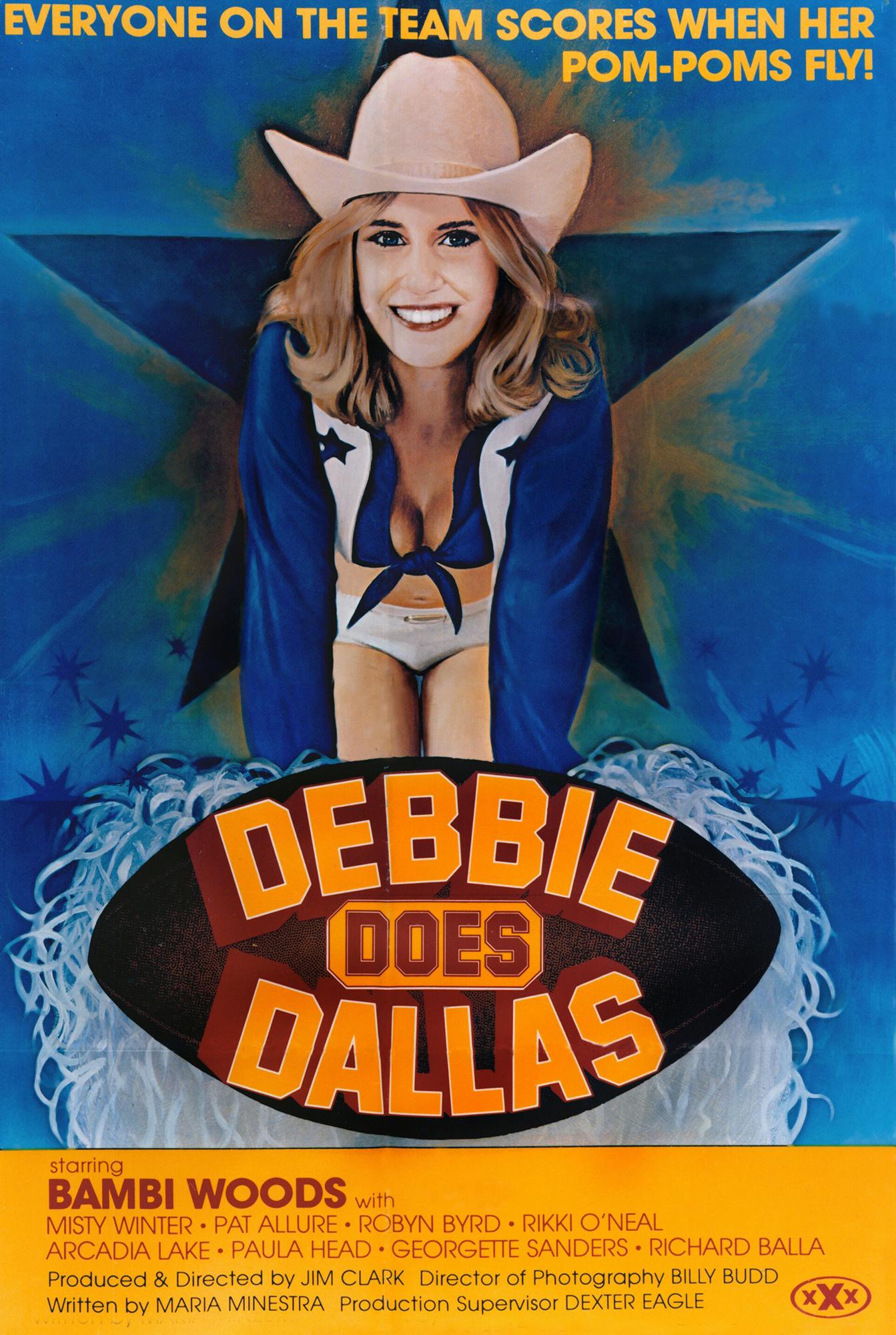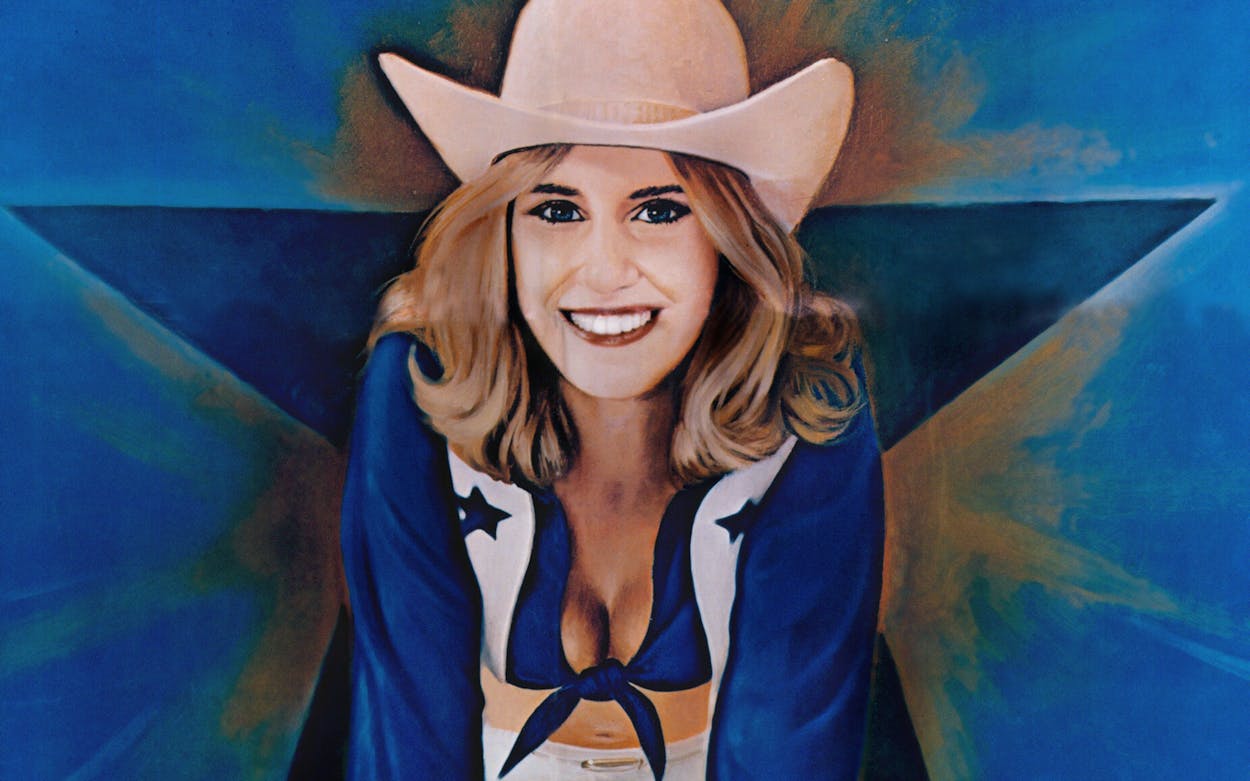How do you capture XXX-rated lightning in a bottle? In the case of Debbie Does Dallas, you start with a title—one so splendidly alliterative, so lusciously evocative, that it hardly matters that, over the course of the picture’s 83-minute running time, Debbie never actually travels to the titular Texas city. Next, you tap directly into the late-seventies cultural zeitgeist with a “plot” that finds our heroine dreaming of joining the world-famous “Texas Cowgirls” (read: Dallas Cowboys Cheerleaders). In the lead role, you cast Bambi Woods, blond and wide-eyed, never before seen and rarely seen since, a girl-next-door fantasy come delicately and ephemerally to life. And finally, since all iconic porn requires an equally iconic tease, you turn the movie into a game of delayed gratification. Indeed, the biggest surprise of all about Debbie Does Dallas, especially for those of us who’ve come of age in the era of Internet porn-on-demand, is that it takes a full 70 minutes before Debbie actually “does” anyone. (And no, the lucky guy does not hail from Dallas.)
Filmed in Manhattan and Brooklyn and on Long Island, in locations “borrowed” by the producers, who told anyone who asked that they were making an “educational film,” Debbie Does Dallas might not seem like a Texas cinematic classic. Nor is the film’s thirtieth anniversary (it was shot in the summer of 1978 and opened at Los Angeles’s Pussycat theaters later that year) likely to be celebrated by film historians. But this micro-budget movie, which according to some estimates went on to make more than $100 million in theatrical and home video sales, deserves our respect. As a satire of the then widespread obsession with the Cowboys cheerleaders, it’s brazen and biting—a sledgehammer to the myth that those pom-pom shakers represented nothing more than apple pie wholesomeness and all-American bonhomie. And as an example of golden-era porn, it’s unexpectedly charming and even vaguely feminist: the story of a group of young women determined to take their destinies, among other things, into their own hands. It was the last gasp of fresh air for an increasingly cynical and puerile genre.
Right from the start, Debbie Does Dallas plays a terrific joke on the audience. When Debbie announces that she’s going to travel to Texas to join the Cowgirls squad, her cheerleader friends are agog with excitement and eager to help raise the necessary funds. But though they soon begin accepting money from their employers in exchange for sexual favors, these young ladies are no cheap sluts. Instead, they approach each business transaction with ingenuousness, open-mindedness, and a pay-what-you-can-afford philosophy. (It’s like “free day” at the museum.) Even when the women in the film function as little more than objects of adolescent wish fulfillment—such as when, in the climactic scene, Debbie dons a blue-and-white Cowboys cheerleader–inspired outfit and hooks up with her boss (Robert Kerman)—they seem to take uncommon, even giddy, pleasure in their escapades. Forget Julia Roberts in Pretty Woman or Shirley MacLaine in Irma la Douce; these are the original whores with a heart of gold.
Needless to say, the Dallas Cowboys didn’t look kindly upon the picture and, in early 1979, filed a trademark infringement lawsuit against the owner of the Pussycat theater chain. You can hardly begrudge the team its indignation. Whether the film’s creators realized it or not, they had served up a spirited attack on the mixture of promiscuity and piety that was promulgated on Sunday afternoon at Texas Stadium. All rhinestone and cleavage and Mary Kay makeup, the Cowboys cheerleaders were an erotic daydream just chaste enough that you wouldn’t feel too guilty watching (especially if you had just gotten out of church). Debbie Does Dallas exposed the base impulses at the center of this daydream. It asserted that, rather than wanting to watch pretty women almost bust out of their halter tops, heterosexual men vastly preferred to see good girls gone completely to seed. (In a particularly brilliant, if illegal, bit of marketing, theater marquees and print ads falsely proclaimed that Woods was an “X-Cowgirls Cheerleader”—hinting that she had suffered some sort of fall from grace and landed flat on her back, with her legs in the air.)

By now, of course, it’s a cliché to wax nostalgic about seventies porn (to wit: Paul Thomas Anderson’s overwrought Boogie Nights and the hagiographic documentary Inside Deep Throat). But you can’t deny Debbie Does Dallas’s influence; an entire cottage industry of gonzo porn—the kind that’s usually shot during spring break and features very drunk coeds blithely flashing the camera—owes the film a considerable debt. More to the point, Debbie is a hoot. There’s a full ten minutes of corny dialogue and cheeky nudity before anyone even has sex. The screenplay is populated with all sorts of eccentric details, such as candle shop owners named Mr. and Mrs. Hardwick (Eric Edwards and Robin Byrd) and a town librarian (Jake Teague) who spends his days reading E. M. Forster while struggling to contain his spanking fetish. And the performers’ bodies look refreshingly, startlingly normal. Women have curves; men haven’t waxed every stray hair from every last crevice.
Okay, maybe Debbie Does Dallas doesn’t deserve a place in the Texas canon alongside Giant or No Country for Old Men. And we certainly shouldn’t ignore its most pernicious legacy: that, as one of the earliest movies of its kind to be released on Beta and VHS, it helped to usher pornography into our living rooms and bedrooms. But in these hypersexualized times—as Web sites like XTube allow every last person on the planet to become his very own adult movie star, as even a fifteen-year-old pop princess like Miley Cyrus has to be packaged as jailbait in the pages of Vanity Fair—its fundamental lesson bears repeating: When it comes to sleaze, a little bit of sincerity goes a long way.
The XXX Files: Debbie behind the scenes.
If watching Debbie Does Dallas makes you curious about its behind-the-scenes saga, check out the 2005 British documentary Debbie Does Dallas Uncovered. (It was never released theatrically in the United States but is available on DVD.) In just 48 lurid, information-crammed minutes, director Francis Hanly explores the film’s scandalous reception and the lingering mystery of what became of star Bambi Woods, who seemed to vanish from the face of the earth shortly after appearing in two Debbie sequels in the eighties. Some of the material here—especially about organized crime’s grip on the porn industry—will seem familiar to those who’ve seen Inside Deep Throat, and the sequence where Hanly hires a private investigator to track down Woods is decidedly half-baked. But if only for the scenes in which Debbie luminaries watch their much younger selves on-screen, this documentary makes for a poignant (if grotesque) trip down memory lane.







